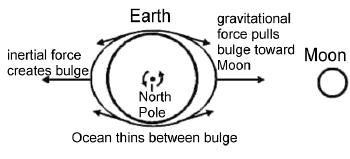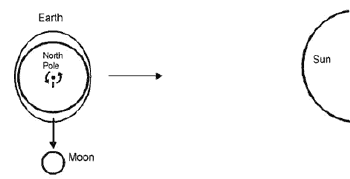|

Tides caused by the Moon. Note that the length of the arrows is
proportional to the strength of gravitational force.
|
One consequence of motions of the Sun, Moon, and Earth
is the creation of the tides. A tide is the alternating rise and fall of the
ocean’s surface. Humans have noticed this change since early times. The
tides were initially explained through myths and tales involving
supernatural forces. Later, early scientists like Poseidonius of Syria and
Pytheas of Marseilles saw a connection between the Moon and the changing
ocean levels. Aristotle, Pliny and Caesar also noticed that the Sun had
an affect on the level. However, the reasons for these connections remained
a mystery.
The problem was solved by Sir Isaac Newton in the
latter part of the 17th century. He proposed that the tides were caused by
the gravitational interaction between the Earth, Sun, and Moon. The basic
premise of Newton’s explanation can be understood by first considering
just the gravitational attraction and motions of the Earth and the Moon. In
this system, at each point on the Earth, there are generally two high and
two low tides per day. As shown in the picture on the next page, the
gravitational attraction of the Moon causes the Earth’s oceans to bulge
upward toward the Moon. The bulge occurs because the part of the ocean
closest to the Moon is pulled more; remember that the gravitational
attraction between two objects is greater if they are closer together. On
the opposite side of the Earth, inertia from the Earth’s rotation on its
axis raises a second bulge in the ocean, opposite the first one. To
accommodate these two rises in ocean level, ocean level drops between them,
as shown in the diagram. These two bulges and low points remain essentially
stationary. As the Earth rotates, completing one spin in 24 hours, each
point on the Earth’s surface passes under both bulges and low points. We
experience the resulting rise and fall of ocean level as the tides.
|

Spring Tide - Maximum high and low tides occur when the Moon
and sun line up. Note: the Moon can also be on the other side of the
Earth.
|
The tides are actually much more complex than this
simple explanation. Other factors in the rise and fall of the tides include:
1) the gravitational attraction of the Sun; 2) the changing distances
between the Earth, Moon, and Sun; 3) variations in the Earth’s rotation;
and 4) the shape of the Earth’s ocean basins and coastlines.
Of these, the most significant is the influence of the
Sun. When the Sun and Moon are aligned, their gravitational attraction on
the Earth’s ocean work together to produce extremely high and low tides.
These are a called spring tides. When the Moon and Sun are at right angles,
their gravitational attraction works at right angles, producing tides of
minimum height. These are called neap tides.
PROCEDURE:
Use the following demonstrations to review how the Earth moves in
space and what happens during its movements.
- Hold the globe upright and review the parts of the Earth. Ask
students to show the locations of the North and South Poles, the
equator, and the Earth's axis. Have them point out lines of
longitude and latitude.
- Ask students what word(s) describe the shape of the Earth. Ask
them if the Earth is a perfect sphere. (No: as the Earth rotates, spin
causes the polar regions to flatten out and equatorial areas to
bulge, making the Earth vaguely egg- or pear-shaped.)
- Hold the globe with the axis upright. Have one student shine the
flashlight on the globe. Ask them what the light represents (the
Sun). Ask the students if the Earth is correctly positioned in
space. (No, the Earth's axis is tilted 23 1/2 degrees.) Next, tilt
the globe so that the North Pole is inclined toward the
"Sun".
|

Neap tides - Minimum high and low tides when Sun,
Earth, and Moon are at right angles.
|
- Ask the students what difference this makes to temperatures on the
Earth’s surface. (The North Pole and Northern Hemisphere receive
more direct light, so are warmer, while the South Pole and Southern
Hemisphere receive less, so are cooler.) This is the basic cause of
the seasons, which will be covered more in Lab.
- Ask the following questions about motions in the Earth/Moon/Sun
system. Demonstrate the answers. What revolves around the Sun? (the
Earth with its Moon.) What revolves around the Earth? (The Moon).
Which bodies rotate? (the Earth, Moon, and Sun)
Here are other, optional general questions:
- Is the Sun a planet? (No, a star.)
- Is the Moon a planet? (No, a satellite.)
- How long does it take for Earth to make one full rotation? (24
hours.)
- How long does it take for Earth to revolve one time around the
Sun? (365 1/4 days or 1 year.)
- How long does it take the Moon to rotate once around the Earth?
(almost 28 days.)
- How long does it take for the Moon to revolve around the Earth?
(almost 28 days.)
- Does the Sun revolve around anything? (Yes - the core of the Milky
Way Galaxy.)
- Explain tides to the students.